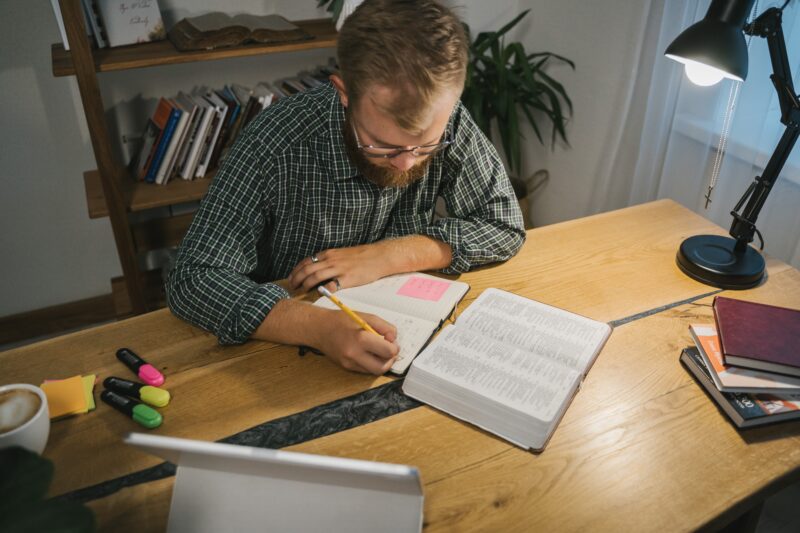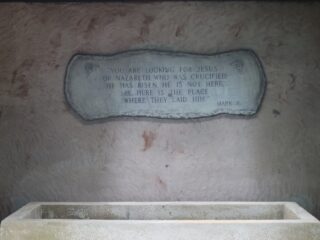For over eleven years, I was the teaching pastor of Kairos, a worship service for young adults at Brentwood Baptist Church. A lot of the young adults who came to Kairos were coming to their first experience of church and worship. Some of my favorite stories of my ministry come from these Tuesday nights.
And some of those stories include helping these young adults get over their fear of reading the Bible. Most of them didn’t have a Bible. Their parents had given them one when they were children, but that Bible was either back at home or long since lost. The first challenge was getting them a Bible.
So, here’s the first step in my never-fail reading plan: GET A BIBLE. Get a real Bible. You know, a real Bible with real paper pages that are held together by leather or cloth binding. I know, you can get any number of Bible software packages and Bible apps, and these are fine; however, they can be overwhelming and distracting to beginners.
Just get a Bible—any Bible you’re comfortable with. I know scholars and theologians will argue over the best and most accurate translations, but for most of us, any of the usual translations will be fine. If it starts with Genesis and ends with Revelation, you can’t go wrong. Find one you are comfortable with and let it be your Bible.
Now, find a place and a time that will work for you most every day. No one time is going to be perfect for all seven days of the week, but find a time and place—the same time and same place—where you can show up, and your body knows you’re about to start studying the Bible. We are creatures of habit, and by establishing that this is the place and time you study the Bible, your mind will prepare for studying when you begin to walk to your favorite chair. (For me, it’s my favorite chair. Your favorite place may be someplace else.)
Just find whatever place and time works for you and start showing up. That’s all. Now, here’s the good news: you’ve done better than most people by simply showing up. Most people intend to study their Bibles, but they never get to the place of even starting. You have shown yourself to be exceptional simply by showing up.
Now, for the hard part. Read the Bible. I want to remind you that we’re not going to read the whole Bible today. In fact, we probably won’t read the whole Bible this week. We’re going to be reading the Bible in one way or another for the rest of our lives. We’ll eventually get through it, but we’re in no rush. Some things, like a fine meal, need to be savored. Reading the Bible isn’t so much an effort to push through the text as it is a meal to be savored and experienced.
So, where do you start? Start with the gospel of Mark. Mark was the first gospel written, and it’s a good way to understand the ministry and teachings of Jesus. Almost half of Mark (chapters 11-16) is about the last week of His earthly ministry. When you finish reading Mark, read it again. We only comprehend about 20% of the text the first time we read it. Read Mark until you almost know it from memory.
Read slowly. Remember that we’re learning a life-long practice, not sprinting to the end of the book. When you come across a story or a verse that makes you stop and think, then stop reading and write in your journal. I’m old school on journaling, so use a paper journal and a good pen to write out your thoughts. There is something about writing longhand that engages your brain in a different way than typing things out on your computer. And if you’re worried about not having anything to say, don’t worry. Something happens when your pen hits the paper. You’ll find yourself writing things you hadn’t thought about in years. There’s a reason that keeping a journal has been a highly regarded spiritual discipline for generations. The soul has a way of revealing itself in writing.
Write until you’re done. That may be 30 minutes or it may be five minutes. I’m really not interested in how long you stay in your Bible reading time. I’m more concerned with a) building a daily habit of Bible study and b) getting the Word off the pages of the Bible and into your head.
Here’s the thing about studying the Bible. Once you read the passage or story a couple of times, it stays with you. You’ll find yourself thinking about the passage while you wait on an elevator or while you’re stuck in traffic. You’ll find yourself retelling the passage to your friends during a casual conversation. In short, the Bible will become part of your life.
And that’s the whole point.
When you finish with Mark, read Matthew and Luke. Read them the same way—slowly. Then, read John. The reason you read John last is that he’s the poet of the group. He is concerned with showing what everything means. He doesn’t really care about history, so to fit his purpose or to show some important insight, he’ll purposely tell things out of order. For instance, in Matthew, Mark, and Luke, Jesus cleansed the Temple on the first day of Holy Week. In John, it’s one of the first things Jesus does.
Why? Because for John, the whole point of Jesus’ coming was to break down the barriers that keep us from God. John seems to be telling us that if we want to know anything about Jesus, then we need to view the entire ministry of Jesus through the lens of the Temple cleansing.
Don’t get hung up on how much you read or how fast you read. Focus on reading deeply. Christ has promised that when we open His word, He’ll meet us in the pages of Scripture. How awesome to know that when we open the Bible, we open the Bible in the presence of its Author. The conversations that follow promise to be life-changing.









